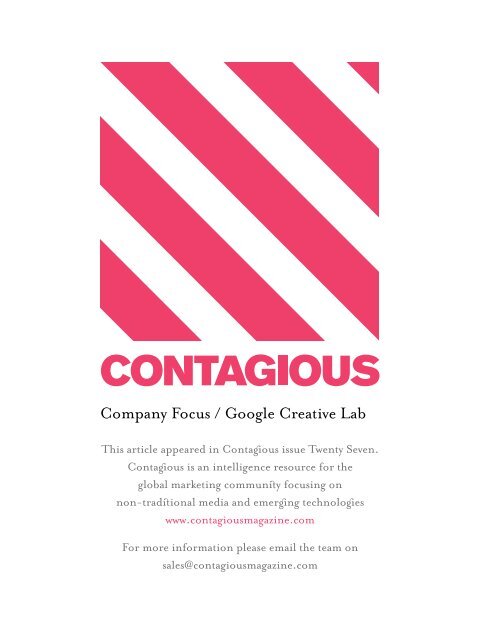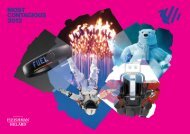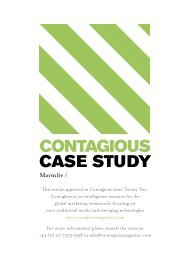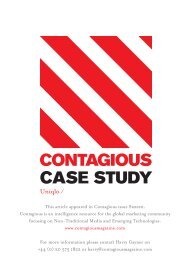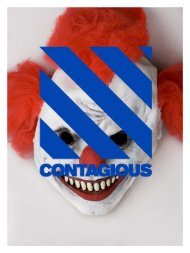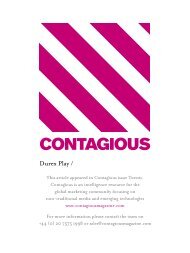Download - Contagious Magazine
Download - Contagious Magazine
Download - Contagious Magazine
You also want an ePaper? Increase the reach of your titles
YUMPU automatically turns print PDFs into web optimized ePapers that Google loves.
Company Focus / Google Creative Lab<br />
This article appeared in Contagous issue Twenty Seven.<br />
Contagous is an intelligence resource for the<br />
global marketing communiy focusing on<br />
non-tradiional media and emergng technologes<br />
www.contagiousmagazine.com<br />
For more information please email the team on<br />
sales@contagiousmagazine.com
company focus / google creative lab /<br />
Company Focus / Google Creative Lab / Think,<br />
Make, Do / You’ve got to admire a marketing team<br />
whose aim is to win the Nobel Peace Prize. And<br />
when those people are a bunch of artiss, designers,<br />
creatives and technologiss at Google, you wonder<br />
if i might jus be possible / By Emily Hare /<br />
youtube play /
Google Creative Lab selects its interns based,<br />
amongst other things, on their capacity to be humble,<br />
and it’s easy to see why. It doesn’t want to breed a<br />
bunch of people who, aged 23, will be bragging about<br />
working on a Super Bowl spot; creating a music<br />
video for Arcade Fire and developing a movie which<br />
premiered at Sundance (after YouTube, of course). Yet<br />
despite their reverence for humility, the team, based in<br />
New York, San Francisco and London, are not without<br />
epic amounts of ambition. Executive creative director<br />
Robert Wong proclaims: ‘When I hire creatives I tell<br />
them that if your goal is to win a Cannes Lion this is not<br />
the place for you. Our goal is to win the Nobel Peace<br />
Prize. It’s more of a symbolic goal, but what it does is<br />
reframe the possibility of what you can do for any brand<br />
or company with their products.’<br />
The Lab was launched in November 2007 by Andy<br />
Berndt, formerly co-president of Ogilvy New York.<br />
It aimed to lead the creative efforts of Google’s<br />
marketing department, while allowing its small team of<br />
around 50 people to tinker and experiment, focusing<br />
across the entire range of the company’s offering. The<br />
Lab produces work both independently and through<br />
collaborations with agencies and partners. Considering<br />
the Google brand and its creative standards, Berndt<br />
felt that a creative hothouse was needed, because<br />
the company is so different from any other in terms<br />
of how it communicates and markets to the world. He<br />
explains: ‘Creative Lab combines Yin and Yang, its leftbrain<br />
and right-brain thinking. We use a combination of<br />
really smart marketing and manifestations of what the<br />
products do to represent the magic that is inside them.’<br />
Made up of designers, writers, storytellers, filmmakers,<br />
animators and creative coders, Robert Wong sees the<br />
Creative Lab’s aim as: ‘Using the dark arts of creativity<br />
to do for the brand what the engineers do… build<br />
products.’<br />
In essence, as Wong explains, this boils down to<br />
‘making cool shit instead of making meetings’. Ben<br />
Malbon, the Lab’s director of strategy, shares a similar<br />
sentiment on page 20, in a piece on the role of the chief<br />
innovation officer. In reality, this incorporates a stripped<br />
down planning process, constant experimentation<br />
and the ability to scale up projects very quickly. This<br />
is partially possible thanks to the Lab’s self-imposed<br />
startup working mentality – time, funds and people are<br />
all relatively scarce, with projects often turned around<br />
in 24 hours. Wong elaborates: ‘Google has a bi-polar<br />
thing – on the one hand there’s extreme scarcity, but<br />
on the other hand there’s an abundance of resources.<br />
So we start off with scarcity of time, scarcity of<br />
contagious 78 / 79<br />
resources; and you have a weekend and $50 to make<br />
something. And when that thing is really cool… boom,<br />
we put all our resources behind it.’ Tom Uglow, creative<br />
lead of Creative Lab EMEA, adds: ‘Basically I surround<br />
myself with people who I think are really good and then<br />
I try and get them to have fun and experiment. But it’s<br />
always towards a goal, and the goal is always “what’s<br />
in the user’s best interest”?’<br />
Automagical moments<br />
The majority of Creative Lab’s output takes the form<br />
of a product demonstration, encouraging people to<br />
have an ‘automagical’ response to a platform or piece<br />
of technology such as an operating system, search<br />
engine or mobile app. Automagical is a term used<br />
internally, described by Robert Wong as when people<br />
have ‘a visceral, emotional reaction’ to technology.<br />
Just imagine yourself forwarding the Arcade Fire’s<br />
Wilderness Downtown video to your parents, showing<br />
someone running along the street where you grew up,<br />
thanks to Google Maps and Street View, and you’ll<br />
understand what he means.<br />
3 dreams of black /<br />
These moments of magic were continued in the next<br />
iteration of director Chris Milk and creative director<br />
Aaron Koblin’s collaboration, working this time with<br />
North Kingdom and Mirada to develop Rome: 3 Dreams<br />
of Black, an interactive 3D journey built in WebGL,<br />
part of the HTML5 canvas. Users steer themselves<br />
through their 3D ‘dream’ interacting with creatures and<br />
obstacles, backed by the track Black by Dangermouse<br />
and Daniele Luppi.
company focus / google creative lab /<br />
3 dreams of black /<br />
demo slam /<br />
Levels of engagement<br />
<strong>Contagious</strong>’ coverage of ‘mass & niche’ strategies has<br />
shown how brands can engage dedicated fans while<br />
still creating a connection with those who have more of<br />
a passing interest. Creative Lab’s work invites users in<br />
on a number of levels, connecting with everyone from<br />
highly skilled programmers, filmmakers, and prolific<br />
web users to those who would prefer to comment, like<br />
and share, or even passively watch a piece of content.<br />
Uglow sees the group beyond content creators as the<br />
most vital in terms of spreading a piece of work: ‘They’re<br />
the ones that actually generate all the comments and<br />
the interest, they tweet and they buzz and they share.<br />
You take all of that energy that’s been bouncing back<br />
and forth and you transform it into something which is<br />
a truly passive broadcast experience. So then you have<br />
a million subscribers who are quite passively observing<br />
and consuming the interaction, but they’re very much<br />
part of that experience.’<br />
Demo Slam is a site that launched in October 2010,<br />
pitching one video demo of a Google product or service<br />
– such as Google Translate, Voice or Image Search<br />
– against another. Creative Lab worked with creative<br />
agencies Hello Monday and Johannes Leonardo to<br />
encourage films to be submitted by anyone from<br />
Google engineers to bedroom tech tinkerers. Efforts<br />
feature numbers such as the band Weezer testing<br />
Google’s voice search’s accuracy in a concert hall full<br />
of fans chanting their name, to a group of guys filming<br />
themselves dressed as Mt. Rushmore in order to trick<br />
Google Goggles into thinking that they’re the real thing.<br />
The Demo Slampionship ran in February and March<br />
2011 and pitched the top films against each other in a<br />
demo slam /<br />
knockout competition, with the eventual winner picking<br />
up 700,000 views on YouTube along the way. The site<br />
has picked up a Webby and a One Show Interactive<br />
Award.<br />
The Lab extends from such relatively niche initiatives<br />
to the grand repository of American advertising, the<br />
Super Bowl. Sticking with the product demo theme,<br />
a film called Parisian Love was broadcast in 2010<br />
and showed the brand acting as an enabler, using its<br />
various products and platforms to tell the story of a<br />
marriage proposal and spark an emotional connection.<br />
In keeping with its fast and loose approach to<br />
planning and creating work, the Lab is transforming<br />
the traditional model of developing advertising<br />
ideas. Relatively simple ideas can be tested easily<br />
on (Google-owned) YouTube, where the barrier to<br />
uploading and sharing content is so low that traditional<br />
focus groups become redundant. Wong confirms: ‘It’s<br />
definitely easier to make stuff and get stuff out there,<br />
which makes it easy for the brand to then say “hey,<br />
this many people loved it, let’s put some more money<br />
behind it and then more people will”.’<br />
More recently, Google has extended its work for the<br />
Chrome browser with The Web is What You Make of<br />
it, a series of TV spots showing some of the amazing<br />
things that the web has been used for, including<br />
celebrating the It Gets Better Project, which has<br />
generated thousands of videos to help young teens<br />
imagine what a positive future could be like as an<br />
openly gay adult. The film generated almost 5,000<br />
comments on YouTube in ten days, including one from<br />
twilighter3443 which said: ‘I saw this tonight during<br />
Glee. My dad, a man who is uncomfortable around<br />
gays, came in and saw this too. He put his arm round<br />
me and told me he would accept me for anything. I’m<br />
not gay, but I like knowing that change can happen.’ The<br />
work, produced by White House and Lost Planet, New<br />
York, is, according to Robert Wong, built for the new<br />
ecosystem of the web. ‘Our strategy is doing – this is a<br />
product truth and a cultural truth. The profound impact<br />
of the web shows how people are able to impact both<br />
their personal lives and the world at large.’
search on: parisian love /<br />
This sort of impact is achieved with a relatively low<br />
marketing spend compared to rivals. In 2009 Google<br />
spent just $11m across print, online, radio, TV and<br />
outdoor, according to WPP-owned Kantar Media. In<br />
comparison, Microsoft spent $518m and Yahoo! $45m<br />
over the same period. As Michael Lebowitz, Creative<br />
Lab collaborator and CEO of New York-based digital<br />
creative agency Big Spaceship explains; ‘It’s about<br />
being comfortable with constant change and being set<br />
up to cope with real-time change. Google sets a great<br />
example for what a business in an information economy<br />
should do in terms of how it thinks of its products and<br />
its marketing. The Creative Lab is Google’s way of<br />
articulating that, and shows that there is business value<br />
in experimentation.’<br />
Part of this is shown in the instinctive way that the<br />
Lab measures success. Ben Malbon explains: ‘Within<br />
Google clearly there are business goals and within<br />
product groups there are product goals and key<br />
objectives, but more fundamentally for us we often use<br />
simpler, more direct measures to work out whether<br />
we think something’s been successful. Are people<br />
here, not just in the Creative Lab, but around us in the<br />
buildings we work in, proud when they see our work?<br />
Are they proud to work at Google? And, I think that’s<br />
at least one part of our target: to make people who<br />
work here feel that they work somewhere that does<br />
things that are progressive, does good somehow with<br />
technology, that scales quickly and that is open. If you<br />
can do that in a way that is entertaining or somehow<br />
magical it creates something that is more memorable<br />
than just a utility.’<br />
Hypercollaboration<br />
The benefits of collaboration – both internally and<br />
with other agencies and partners – are manifest. All<br />
projects are displayed on the walls of the Lab in the<br />
hope that fortuitous sparks happen and ideas develop.<br />
Wong explains: ‘The more connected people are, the<br />
more ideas connect, so we physically put everyone in<br />
as small a space as possible; it’s almost like designing<br />
a computer chip. Pretty much everyone is commenting<br />
on everyone else’s work throughout the day.’<br />
Malbon describes the process of working with<br />
external agencies as ‘hypercollaborative, completely<br />
contagious 80 / 81<br />
chrome speed tests /<br />
ego free’. He adds: ‘We work best with agencies that<br />
want to become one team with us.’ Compared with<br />
working in an agency – Malbon was previously director<br />
of innovation at BBH, New York – the planning process<br />
is completely stripped back to what he describes as<br />
‘applied strategy’. Malbon explains: ‘Planning is used to<br />
understand the user, understand the product and the<br />
magic behind it, and to try and connect the two via all<br />
of the creative people here.’ Agency partners include<br />
BBH, Johannes Leonardo and Big Spaceship from the<br />
agency world, companies such as Pixar and individuals<br />
including Ridley Scott and director Kevin Macdonald.<br />
However, the process is not always an easy one, as<br />
Malbon explains: ‘We try and warn agencies about how<br />
much of a nightmare we’re going to be to work with.<br />
We say that one day you might be filling an egg cup<br />
with water and the next day you might be trying to boil<br />
the Atlantic Ocean. Can you go from doing virtually<br />
nothing to doing something that’s virtually impossible?<br />
Can you move from small to fast in terms of scaling a<br />
project? Because when Google decides it wants to do<br />
something, it’s decisive and it happens.’<br />
All boats rise<br />
The peripheral benefits of creating inspiring and<br />
ground-breaking work are that other agencies, brands<br />
and companies are inspired to create work that<br />
incorporates some of these ideas, extending Google’s<br />
products and beliefs into further campaigns and sites.<br />
In a wider sense, this contributes to the improvement<br />
of the internet as a whole. Andy Berndt believes: ‘It is<br />
doubly motivating: to create something that is beautiful<br />
and masterful, and – which is almost more inspiring –<br />
to know that the work will spark more ideas.’<br />
As a result, the Lab often receives requests and<br />
enquiries from agencies and brands looking to<br />
emulate its work, and sometimes acts as facilitator,<br />
recommending agencies or departments within<br />
Google who can help to develop campaigns. Malbon<br />
believes: ‘It is a responsibility to be open to the creative<br />
community and agencies in particular so that they can<br />
use and find our products and get expert help with<br />
using them. But also, even more proactively than<br />
that, we probably should do more work reaching out<br />
to people and sharing how we’ve done stuff. I don’t<br />
think there should be any state secrets in terms of how<br />
communications have been built here. I think our job<br />
should be to demystify how it works, rather than to<br />
hoard secrets.’
company focus / google creative lab /<br />
Looking to the future is a challenge in itself, as the<br />
pace of change within Google is so rapid. Nathan<br />
Martin, founder and CEO of post-digital shop<br />
Deeplocal, Pittsburgh, believes it is vital for the Lab to<br />
maintain its startup mentality: ‘It’s rare that a successful,<br />
organically evolved company will attempt to replicate<br />
the seed that started it all. With Creative Lab, we see<br />
a company respecting the values Google was born<br />
with – a lot of hard work and a little bit of chaos. The<br />
question will be if the Lab can remain autonomous and<br />
grow with the same level of passion that drives startup<br />
companies like Deeplocal and the early stage Google.<br />
If any company is able to build a seed of itself from<br />
within, Google would be the company capable of it.’<br />
However, Berndt remains unconcerned about not<br />
knowing quite what is around the corner: ‘The only way<br />
that we think about the future is hiring great people and<br />
partners who are permanently curious and interested<br />
and always want to play with every new toy without<br />
prejudice.’ He adds: ‘At the heart of Google is the<br />
idea that if people have access to information and the<br />
tools to use it then the world gets better. That unites<br />
us, helps us decide what to focus on and enables us<br />
to have great relationships with our partners. There is<br />
much camaraderie in helping the world get better.’<br />
CASE STUDIES /<br />
Arcade Fire / Wilderness Downtown<br />
The Wildnerness Downtown is a personalised music<br />
video which pulls images from Google Maps and<br />
Street View to create a multi-stage visual and narrative<br />
journey based around the street where the user grew<br />
up, accompanying the Arcade Fire’s song We Used<br />
To Wait. Layers pop up all over the viewer’s screen,<br />
sensing the display size and making use of the full<br />
area available, and of course, the whole experience<br />
is designed in HTML5 to demonstrate the speed and<br />
power of the Chrome browser.<br />
The product demo experience was so subtle that it<br />
foxed USA Today’s Whitney Matheson, who wrote:<br />
‘The clip requires Google Chrome, but if you haven’t<br />
downloaded it, you might as well now. (Google should<br />
just use this as an ad for their browser.)’<br />
Directed by Chris Milk, the project was led by Google<br />
Creative Lab’s artist Aaron Koblin, collaborating with a<br />
large team from @radical.media, B-Reel and friends like<br />
designer/developer Mr. doob. The project falls under<br />
the Chrome Experiments banner which showcases<br />
work by artists and programmers built using the latest<br />
technologies, such as HTML5, Canvas and WebGL.<br />
Therefore, this project appeals not only to fans of the<br />
band, but also to fans of web development who may be<br />
entirely unaware of Arcade Fire, not to mention awards<br />
juries. So far this year, it has already claimed two Gold<br />
ANDY Awards, four Webbys, SXSW’s Best of the Best<br />
Award and FWA’s Site of the Year.<br />
Robert Wong explains: ‘I know for me, it was one of<br />
the first times that I felt an emotional connection with<br />
a piece of technology.’ He adds: ‘While I’m proud of<br />
the piece of work, I’m also proud of the 10,000 other<br />
things that are going to happen because of that. At<br />
the end of the day we’re really interested in anything<br />
progressing on the web.’<br />
www.thewildernessdowntown.com<br />
YouTube / Life in a Day<br />
The idea for Life in a Day sprang from one of Google’s<br />
internal Dragon’s Den-style competitions, where<br />
Googlers come together to pitch their top projects<br />
to a panel of judges. The project has pushed usergenerated<br />
content about as far as is possible to go:<br />
people all over the world were asked to film anything<br />
on 24 July to contribute to a documentary about a<br />
single day on earth and 80,000 people too part.
Recruiting Oscar-winning Kevin Macdonald, director<br />
of The Last King of Scotland and Touching the Void,<br />
and involving Ridley Scott as producer, added a<br />
level of expectation about the quality of footage that<br />
was submitted, which editor Joe Walker wove into a<br />
compelling narrative.<br />
Google worked with production company rehab<br />
studio and creative agency Toaster Ltd, London, to<br />
generate submissions and promote the film. Tom<br />
Uglow explains: ‘Sometimes we forget that there are<br />
two projects, there’s the film and there’s also the work<br />
online. We ended up with 5,000 hours of footage,<br />
which was all tagged, and you’re able to view it<br />
online.’ Creative Lab’s Aaron Koblin also worked on a<br />
giant touchscreen wall to display the raw footage at<br />
Sundance film festival, where the film premiered. The<br />
film’s other premiere, on YouTube, was watched by<br />
13 million people, while the Life in a Day channel on<br />
YouTube has been viewed by over 137 million people.<br />
Life in a Day will be released in cinemas in the UK<br />
on 17 June and in the US in late July. It has already<br />
been awarded a Silver World Medal for both Marketing<br />
Effectiveness and Digital Interactive at the New York<br />
Festival Interactive Advertising Awards.<br />
www.youtube.com/lifeinaday<br />
contagious 82 / 83<br />
Android / Androidify App<br />
Creating the Android character and brand identity for<br />
Google’s mobile operating system was one of Creative<br />
Lab’s first pieces of work. Androidify is another project<br />
that sprang from a bit of creative play and quickly grew<br />
to become the number one free app in the Android<br />
App Store. It allows anyone to create an Android robot<br />
version of themselves, or their friends or family – adding<br />
clothes, hair and accessories.<br />
Uglow praises the idea: ‘Androidify is a product demo<br />
that ties into the brand identity – you actually become<br />
the brand identity, and that’s about as engaged as you<br />
can get. I don’t think I’ve ever seen another brand do<br />
that with its identity.’<br />
Creative Lab designer Jonathan Jarvis started making<br />
Android robot versions of people in the Lab and the<br />
project was scaled up with the help of Larva Labs, New<br />
York. Wong believes: ‘While it’s just a silly, fun personal<br />
thing, it actually makes a cool, big brand statement<br />
about Android – it’s open, anyone has access to it,<br />
anyone can make their own.’<br />
Ben Malbon adds: ‘There was never any question of<br />
what the budget was or what it should be, and actually,<br />
clearly, it was not very expensive. If you’d have said to<br />
someone you’ve got a million dollars to work out how to<br />
make Android feel human, you’d have got to a different<br />
place.’<br />
http://androidify.com<br />
YouTube / Symphony Orchestra<br />
The quest to build the web’s first ever collaborative<br />
orchestra launched back in 2008, aiming to make<br />
classical music more widely accessible. The YouTube<br />
Symphony Orchestra’s most recent outing was in<br />
Sydney in March 2011, following its first performance<br />
in New York’s Carnegie Hall in 2009. Contestants<br />
were asked to audition via YouTube, submitting a film<br />
of themselves improvising and playing Mothership,<br />
which had been specially written by composer Mason<br />
Bates for the Sydney event. Grammy award-winning<br />
conductor and artistic advisor Michael Tilson Thomas<br />
oversaw the concerts, selecting 101 musicians from<br />
33 countries to take part.<br />
The week-long festival in Sydney culminated in a<br />
performance by the YouTube Symphony Orchestra at<br />
the Sydney Opera House. The concert was streamed<br />
live and viewed 33 million times by people in 189<br />
countries, including 2.8 million watching over mobile<br />
live-streams, making the event one of YouTube’s<br />
biggest ever live streamed events.<br />
YouTube worked with partners such as The London<br />
Symphony Orchestra, Berlin Philharmonic and Sydney
company focus / google creative lab /<br />
Symphony Orchestra, and the event was sponsored<br />
and supported by brands including Hyundai, Qantas<br />
and Telstra. Creative Lab also worked with Obscura<br />
Digital to create massive scale projections both on the<br />
sails of the Opera House and inside the concert hall.<br />
Symphony Orchestra’s democratisation of classical<br />
music, not only for the people watching but also for<br />
the musicians who gained the chance to play in worldfamous<br />
venues, is commendable. Andy Berndt explains<br />
the ‘ongoing fundamental motivation’ from Google’s<br />
founders [Larry Page and Sergey Brin]: ‘Information<br />
is oxygen, and when it’s free, open, shared and<br />
collaborative, society flourishes and competition and<br />
innovation happens.’<br />
www.youtube.com/symphony<br />
youtube symphony orchestra /<br />
Chrome / Fast<br />
Ben Malbon articulates the challenges of promoting a<br />
browser, in a world where selecting Chrome, Firefox,<br />
Safari or Internet Explorer is more often a default choice<br />
than an active decision: ‘No-one really knew if it would<br />
be possible to produce compelling communications<br />
about a browser, because it’s very difficult to explain to<br />
people what it is and most people don’t care.’<br />
He explains the thinking behind ideas and product<br />
demos such as Chrome Fast – a series of virals<br />
produced with BBH New York, to launch the browser.<br />
These tested the speed of Chrome compared to a<br />
potato gun, sound (by loading Pandora) and lightning.<br />
More recently, games such as Chrome Fastball<br />
challenged players to manoeuvre their way along<br />
an obstacle course on a webpage, progressing by<br />
interacting with various Google products.<br />
contagious 84 / 85<br />
youtube symphony orchestra /<br />
Malbon explains: ‘There is actually less planning,<br />
more thinking about the product and what we could<br />
do with it. It’s understanding the product as quickly<br />
as possible, what makes it cool and what makes it<br />
different and awesome, and then starting to experiment<br />
with what we could do with it to try and bring that to<br />
life for people.’<br />
Since Chrome launched in 2008 it has grown to<br />
occupy an 18.3% share of the market, according to<br />
StatCounter, while user numbers tripled in 2010 from<br />
40 to 120 million. And although Google considers that<br />
it has now converted most of the people who care<br />
about what browser they use, its next challenge is to<br />
make those less concerned aware of the potential of<br />
the browser.<br />
According to Robert Wong, ‘In America, people<br />
spend more time in their browsers than they spend<br />
driving their cars. We know that any website is only as<br />
good as the browser that supports it, so the better the<br />
browsers get, the better the web experience gets, and<br />
the better websites can become.<br />
‘It is a big deal – for us, most of our products are<br />
experienced through the web, and we have an interest<br />
in all browsers getting better.’<br />
www.youtube.com/chromefastball<br />
www.youtube.com/googlechrome


